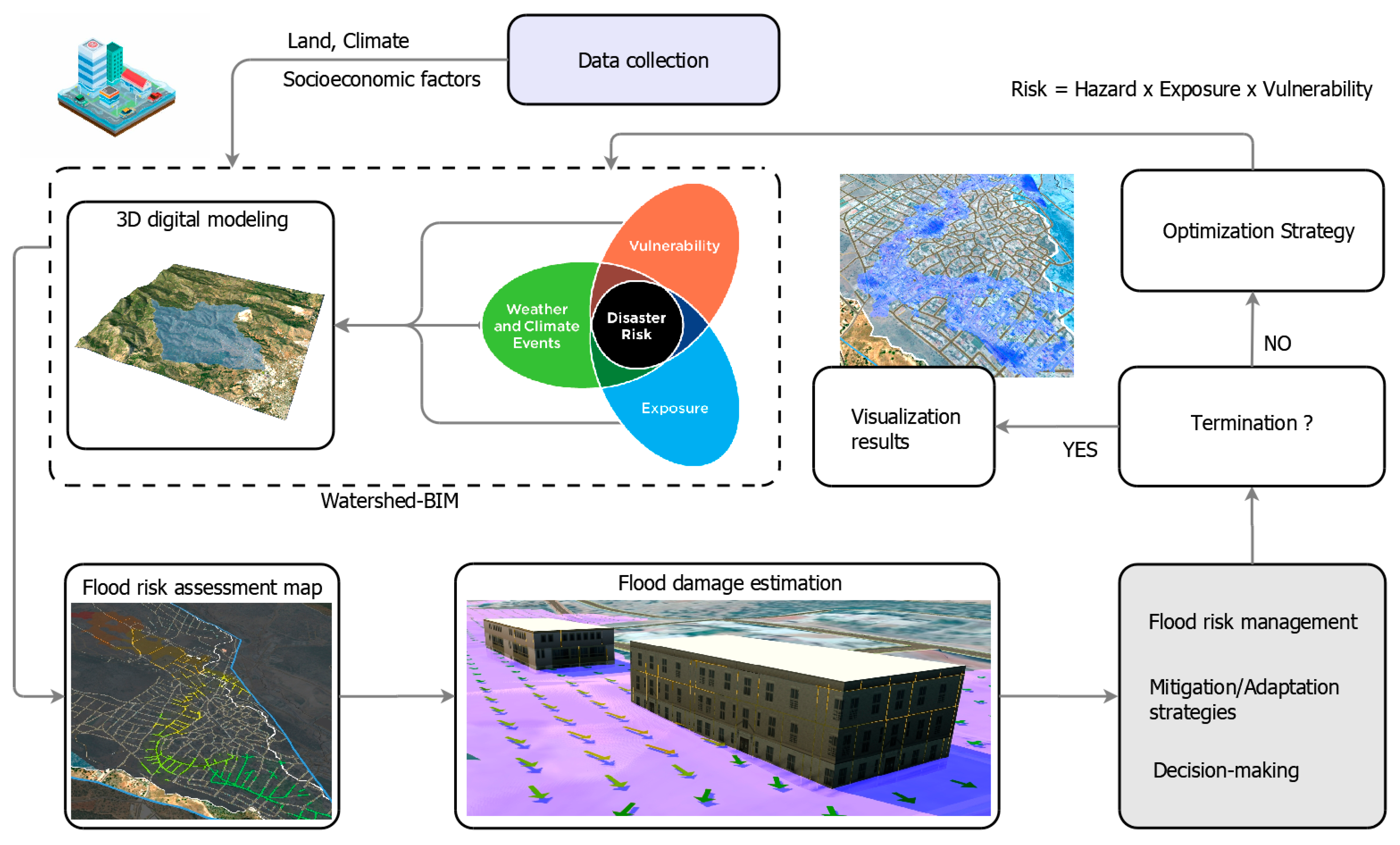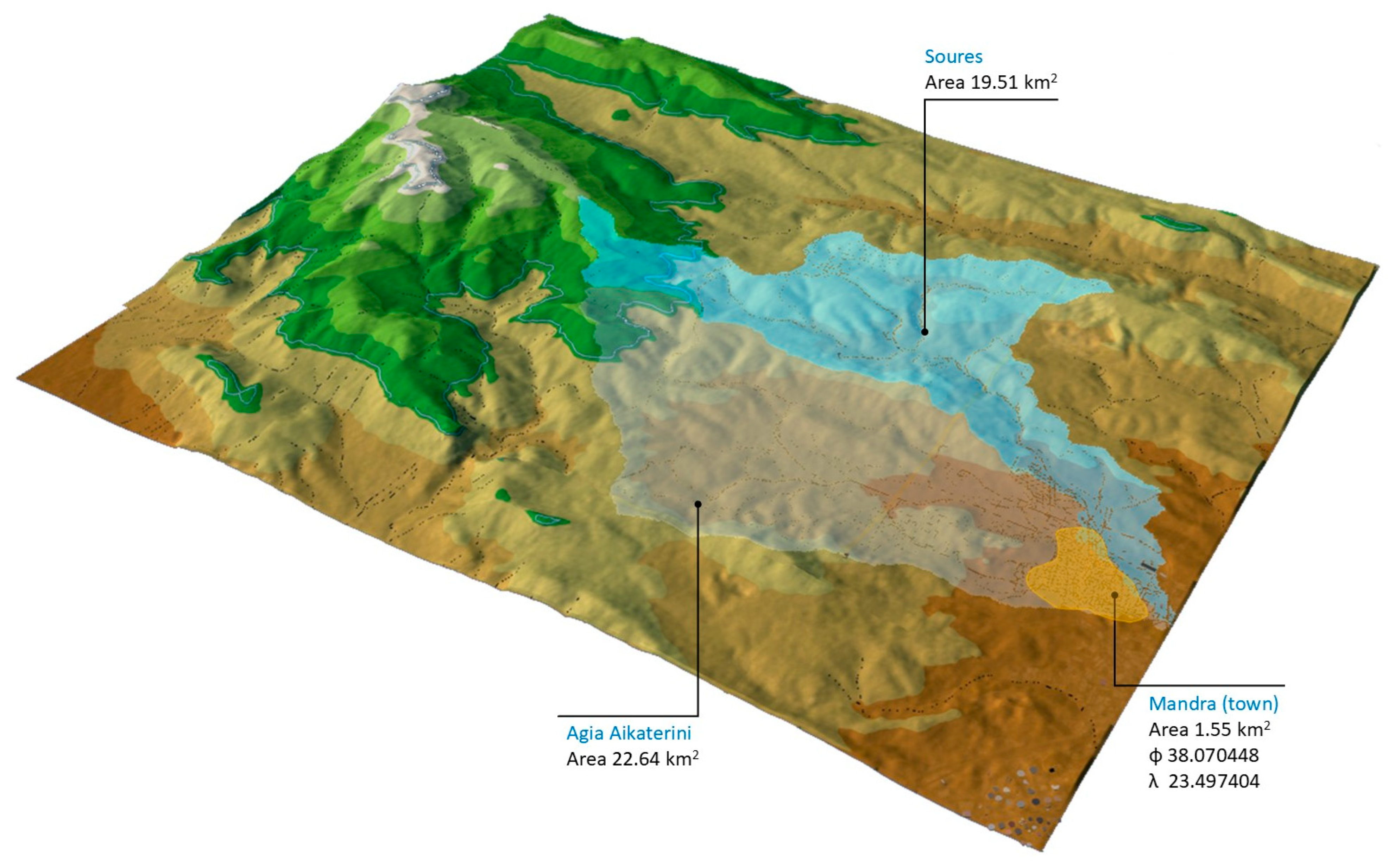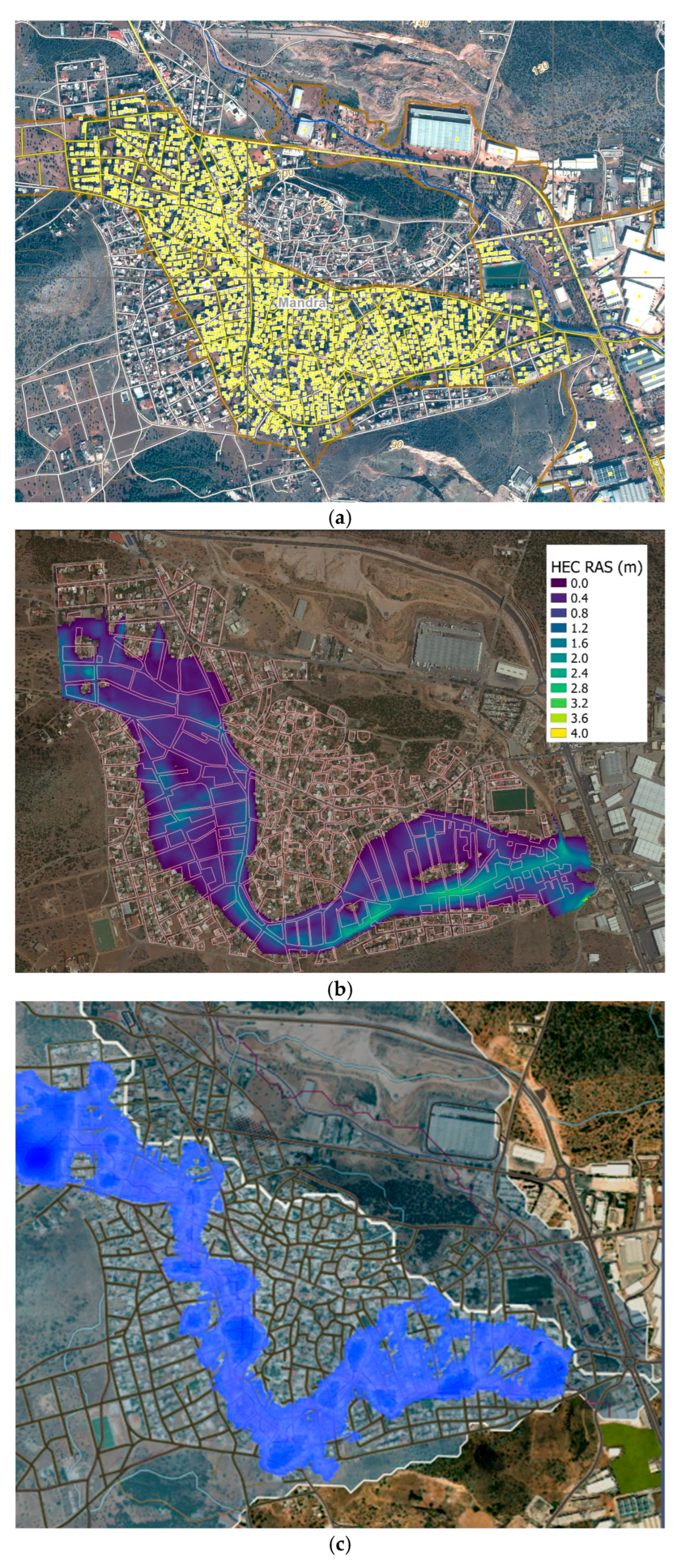Watershed-BIM Integration for Urban Flood Resilience: A Framework for Simulation, Assessment, and Planning
Abstract
1. Introduction
2. Background
3. Flood Risk Management
3.1. Overview of the Watershed-BIM Methodology
- Geospatial, topographic, and climatic data are collected for the watershed and urban area, and the study region is georeferenced. Terrain features (e.g., elevation, land use) and surface types (streams, buildings, soil) are defined and analyzed.
- Building and infrastructure models—typically with low to medium Level of Detail (LoD)—are imported, often in IFC format. These are integrated with GIS data through common spatial references.
- The watershed boundaries and hydrographic network are delineated, slopes are analyzed, and the basin is subdivided into sub-catchments. Key parameters such as rainfall, runoff coefficients, and surface roughness are assigned.
- GIS and BIM data are then used as inputs to hydrological-hydraulic models (e.g., RiverFlow2D) to simulate flow patterns and flood risk.
- Results are visualized both in the BIM environment (for building-scale impacts) and in GIS (for regional-scale analysis). Scenario testing can be performed by altering site features (e.g., adding flood control structures).
3.2. Flood Risk Assessment
- i: rainfall intensity (mm/h),
- tc: concentration time (h),
- T: return period (years),
- K, θ, λ′, ψ′, η: scale, position, and shape parameters of the GEV distribution,
- Ad: the hydrological basin area (km2),
- L: maximum watercourse length in the basin (km),
- Hmref: difference between the mean basin elevation upstream and the bottom of the basin (m),
- Href: elevation at the bottom of basin (m),
- Q: peak runoff flow (m3/s),
- C: runoff coefficient, which mainly depends on the catchment characteristics.
- Cr: watershed relief,
- Ci: soil infiltration,
- Cv: vegetative cover,
- Cs: land surface storage capacity.
| Runoff Coefficient Values | ||||
|---|---|---|---|---|
| Extreme | High | Normal | Low | |
| Watershed relief (Cr) | 0.28–0.35 | 0.20–0.28 | 0.14–0.20 | 0.08–0.14 |
| Soil infiltration (Ci) | 0.12–0.16 | 0.08–0.12 | 0.06–0.08 | 0.04–0.06 |
| Vegetative cover (Cv) | 0.12–0.16 | 0.08–0.12 | 0.04–0.08 | 0.04–0.06 |
| Surface storage capacity (Cs) | 0.10–0.12 | 0.08–0.10 | 0.06–0.08 | 0.04–0.06 |
3.3. Watershed-Building Information Modeling (W-BIM)
4. Case Study: Flood Risk Analysis
4.1. Case Description and Input Data
4.2. Results and Validation
5. Discussion
5.1. Methodological Contributions and Comparative Insights
5.2. Pathways for Further Development
6. Conclusions
Author Contributions
Funding
Institutional Review Board Statement
Informed Consent Statement
Data Availability Statement
Conflicts of Interest
References
- Dharmarathne, G.; Waduge, A.O.; Bogahawaththa, M.; Rathnayake, U.; Meddage, D.P.P. Adapting Cities to the Surge: A Comprehensive Review of Climate-Induced Urban Flooding. Results Eng. 2024, 22, 102123. [Google Scholar] [CrossRef]
- Diakakis, M.; Boufidis, N.; Salanova Grau, J.M.; Andreadakis, E.; Stamos, I. A Systematic Assessment of the Effects of Extreme Flash Floods on Transportation Infrastructure and Circulation: The Example of the 2017 Mandra Flood. Int. J. Disaster Risk Reduct. 2020, 47, 101542. [Google Scholar] [CrossRef]
- Khoshkonesh, A.; Nazari, R.; Nikoo, M.R.; Karimi, M. Enhancing Flood Risk Assessment in Urban Areas by Integrating Hydrodynamic Models and Machine Learning Techniques. Sci. Total Environ. 2024, 952, 175859. [Google Scholar] [CrossRef]
- Cepa, J.J.; Pavón, R.M.; Alberti, M.G.; Ciccone, A.; Asprone, D. A Review on the Implementation of the BIM Methodology in the Operation Maintenance and Transport Infrastructure. Appl. Sci. 2023, 13, 3176. [Google Scholar] [CrossRef]
- Ding, Z.; Xu, S.; Xie, X.; Zheng, K.; Wang, D.; Fan, J.; Li, H.; Liao, L. A Building Information Modeling-Based Fire Emergency Evacuation Simulation System for Large Infrastructures. Reliab. Eng. Syst. Saf. 2024, 244, 109917. [Google Scholar] [CrossRef]
- Pelden, S.; Banihashemi, S.; Mohandes, S.R.; Arashpour, M.; Kalantari, M. Enhancing Infrastructure Planning and Design through BIM-GIS Integration. Struct. Infrastruct. Eng. 2025, 1–20. [Google Scholar] [CrossRef]
- Jongman, B.; Kreibich, H.; Apel, H.; Barredo, J.I.; Bates, P.D.; Feyen, L.; Gericke, A.; Neal, J.; Aerts, J.C.J.H.; Ward, P.J. Comparative Flood Damage Model Assessment: Towards a European Approach. Nat. Hazards Earth Syst. Sci. 2012, 12, 3733–3752. [Google Scholar] [CrossRef]
- Bernhofen, M.V.; Cooper, S.; Trigg, M.; Mdee, A.; Carr, A.; Bhave, A.; Solano-Correa, Y.T.; Pencue-Fierro, E.L.; Teferi, E.; Haile, A.T.; et al. The Role of Global Data Sets for Riverine Flood Risk Management at National Scales. Water Resour. Res. 2022, 58, e2021WR031555. [Google Scholar] [CrossRef]
- Alabbad, Y.; Yildirim, E.; Demir, I. A Web-Based Analytical Urban Flood Damage and Loss Estimation Framework. Environ. Model. Softw. 2023, 163, 105670. [Google Scholar] [CrossRef]
- Cea, L.; Costabile, P. Flood Risk in Urban Areas: Modelling, Management and Adaptation to Climate Change: A Review. Hydrology 2022, 9, 50. [Google Scholar] [CrossRef]
- Soulios, G.; Stournaras, G.; Nikas, K.; Mattas, C. The Floods in Greece: The Case of Mandra in Attica. Bull. Geol. Soc. Greece 2018, 52, 131. [Google Scholar] [CrossRef]
- Mitsopoulos, G.; Diakakis, M.; Panagiotatou, E.; Sant, V.; Bloutsos, A.; Lekkas, E.; Baltas, E.; Stamou, A.I. ‘How Would an Extreme Flood Have Behaved If Flood Protection Works Were Built?’ The Case of the Disastrous Flash Flood of November 2017 in Mandra, Attica, Greece. Urban Water J. 2022, 19, 911–921. [Google Scholar] [CrossRef]
- Varlas, G.; Anagnostou, M.N.; Spyrou, C.; Papadopoulos, A.; Kalogiros, J.; Mentzafou, A.; Michaelides, S.; Baltas, E.; Karymbalis, E.; Katsafados, P. A Multi-Platform Hydrometeorological Analysis of the Flash Flood Event of 15 November 2017 in Attica, Greece. Remote Sens. 2019, 11, 45. [Google Scholar] [CrossRef]
- Diakakis, M.; Deligiannakis, G.; Andreadakis, E.; Katsetsiadou, K.N.; Spyrou, N.I.; Gogou, M.E. How Different Surrounding Environments Influence the Characteristics of Flash Flood-Mortality: The Case of the 2017 Extreme Flood in Mandra, Greece. J. Flood Risk Manag. 2020, 13, e12613. [Google Scholar] [CrossRef]
- Speis, P.D.; Andreadakis, E.; Diakakis, M.; Daidassi, E.; Sarigiannis, G. Psychosocial Vulnerability and Demographic Characteristics in Extreme Flash Floods: The Case of Mandra 2017 Flood in Greece. Int. J. Disaster Risk Reduct. 2019, 41, 101285. [Google Scholar] [CrossRef]
- Khan, I.; Lei, H.; Shah, A.A.; Khan, I.; Muhammad, I. Climate Change Impact Assessment, Flood Management, and Mitigation Strategies in Pakistan for Sustainable Future. Environ. Sci. Pollut. Res. 2021, 28, 29720–29731. [Google Scholar] [CrossRef]
- Devia, G.K.; Ganasri, B.P.; Dwarakish, G.S. A Review on Hydrological Models. Aquat. Procedia 2015, 4, 1001–1007. [Google Scholar] [CrossRef]
- Yu, C.; Duan, J. Simulation of Surface Runoff Using Hydrodynamic Model. J. Hydrol. Eng. 2017, 22, 04017006. [Google Scholar] [CrossRef]
- Teng, J.; Jakeman, A.J.; Vaze, J.; Croke, B.F.W.; Dutta, D.; Kim, S. Flood Inundation Modelling: A Review of Methods, Recent Advances and Uncertainty Analysis. Environ. Model. Softw. 2017, 90, 201–216. [Google Scholar] [CrossRef]
- Banks, J.C.; Camp, J.V.; Abkowitz, M.D. Adaptation Planning for Floods: A Review of Available Tools. Nat. Hazards 2014, 70, 1327–1337. [Google Scholar] [CrossRef]
- Zischg, J.; Goncalves, M.L.R.; Bacchin, T.K.; Leonhardt, G.; Viklander, M.; Van Timmeren, A.; Rauch, W.; Sitzenfrei, R. Info-Gap Robustness Pathway Method for Transitioning of Urban Drainage Systems under Deep Uncertainties. Water Sci. Technol. 2017, 76, 1272–1281. [Google Scholar] [CrossRef]
- Chen, W.; Wang, W.; Huang, G.; Wang, Z.; Lai, C.; Yang, Z. The Capacity of Grey Infrastructure in Urban Flood Management: A Comprehensive Analysis of Grey Infrastructure and the Green-Grey Approach. Int. J. Disaster Risk Reduct. 2021, 54, 102045. [Google Scholar] [CrossRef]
- Bellos, V.; Kourtis, I.; Raptaki, E.; Handrinos, S.; Kalogiros, J.; Sibetheros, I.A.; Tsihrintzis, V.A. Identifying Modelling Issues through the Use of an Open Real-World Flood Dataset. Hydrology 2022, 9, 194. [Google Scholar] [CrossRef]
- Kelesoglu, M.K.; Temur, R.; Gülbaz, S.; Memisoglu Apaydin, N.; Kazezyılmaz-Alhan, C.M.; Bozbey, I. Site Assessment and Evaluation of the Structural Damages after the Flood Disaster in the Western Black Sea Basin on August 11, 2021. Nat. Hazards 2023, 116, 587–618. [Google Scholar] [CrossRef]
- Nkwunonwo, U.C.; Whitworth, M.; Baily, B. A Review of the Current Status of Flood Modelling for Urban Flood Risk Management in the Developing Countries. Sci. Afr. 2020, 7, e00269. [Google Scholar] [CrossRef]
- Salvadore, E.; Bronders, J.; Batelaan, O. Hydrological Modelling of Urbanized Catchments: A Review and Future Directions. J. Hydrol. 2015, 529, 62–81. [Google Scholar] [CrossRef]
- Rong, Y.; Zhang, T.; Zheng, Y.; Hu, C.; Peng, L.; Feng, P. Three-Dimensional Urban Flood Inundation Simulation Based on Digital Aerial Photogrammetry. J. Hydrol. 2020, 584, 124308. [Google Scholar] [CrossRef]
- Rydvanskiy, R.; Hedley, N. 3d Geovisualization Interfaces as Flood Risk Management Platforms: Capability, Potential, and Implications for Practice. Cartographica 2020, 55, 281–290. [Google Scholar] [CrossRef]
- Amirebrahimi, S.; Rajabifard, A.; Mendis, P.; Ngo, T. A BIM-GIS Integration Method in Support of the Assessment and 3D Visualisation of Flood Damage to a Building. J. Spat. Sci. 2016, 61, 317–350. [Google Scholar] [CrossRef]
- Kangwa, K.; Mwiya, B. Flood Simulation with GeoBIM. In Smart and Resilient Infrastructure for Emerging Economies: Perspectives on Building Better; CRC Press: Boca Raton, FL, USA, 2023; pp. 90–98. [Google Scholar] [CrossRef]
- Jang, Y.H.; Park, S.I.; Kwon, T.H.; Lee, S.H. CityGML Urban Model Generation Using National Public Datasets for Flood Damage Simulations: A Case Study in Korea. J. Environ. Manag. 2021, 297, 113236. [Google Scholar] [CrossRef]
- Wang, C.; Hou, J.; Miller, D.; Brown, I.; Jiang, Y. Flood Risk Management in Sponge Cities: The Role of Integrated Simulation and 3D Visualization. Int. J. Disaster Risk Reduct. 2019, 39, 101139. [Google Scholar] [CrossRef]
- Liu, H.; Su, H.; Li, H. Study on Digital Twin Technologies for Watershed Information Modeling (WIM): A Systematic Literature Review and Bibliometric Analysis. Arch. Comput. Methods Eng. 2024, 31, 263–289. [Google Scholar] [CrossRef]
- Yang, Y.; Ng, S.T.; Dao, J.; Zhou, S.; Xu, F.J.; Xu, X.; Zhou, Z. BIM-GIS-DCEs Enabled Vulnerability Assessment of Interdependent Infrastructures—A Case of Stormwater Drainage-Building-Road Transport Nexus in Urban Flooding. Autom. Constr. 2021, 125, 103626. [Google Scholar] [CrossRef]
- Syed Abdul Rahman, S.A.F.; Abdul Maulud, K.N.; Wan Mohd Jaafar, W.S. BIM-GIS in Catalyzing 3D Environmental Simulation. In Advances in Geoinformatics Technologies: Facilities and Utilities Optimization and Management for Smart City Applications; Springer: Berlin/Heidelberg, Germany, 2024; pp. 183–200. [Google Scholar]
- Ajmar, A.; Boccardo, P.; Broglia, M.; Kucera, J.; Giulio-Tonolo, F.; Wania, A. Response to Flood Events: The Role of Satellite-based Emergency Mapping and the Experience of the Copernicus Emergency Management Service. In Flood Damage Survey and Assessment: New Insights from Research and Practice; Wiley: Hoboken, NJ, USA, 2017; pp. 211–228. [Google Scholar]
- Pennsylvania Department of Transportation. PennDOT Drainage Manual; Pennsylvania Department of Transportation: Harrisburg, PA, USA, 2008. [Google Scholar]
- European Environment Agency. Urban Adaptation to Climate Change in Europe 2016: Transforming Cities in a Changing Climate; EEA Report No. 12/2016; Publications Office of the European Union: Luxembourg, 2016; Available online: https://www.eea.europa.eu/publications/urban-adaptation-2016 (accessed on 1 June 2025).







| Characteristic | HEC-RAS | WIM (InfraWorks/Civil 3D/RiverFlow2D) |
|---|---|---|
| Digital terrain model | 2D with limited 3D visualization | 3D with detailed topography integration |
| Built environment simulation | Indirect (via terrain or land use classification) | Explicit modeling of buildings and infrastructure |
| Road network simulation | Indirect (through terrain modifications) | Yes |
| Hydraulic network simulation | Open-channel systems; limited for closed drainage | Yes (drainage, pipelines via SSA) |
| Watershed delineation | Manual or GIS-based pre-processing | Semi-automatic (GIS + BIM integration) |
| Hydrological characteristics | Yes (requires external data input, HEC-HMS) | Yes (integrated with spatial layers) |
| Flood simulation robustness | Robust for riverine flooding; limited urban detail | Holistic (terrain, buildings, infrastructure, costs) |
| Interoperability | High (SHP, GeoTIFF, RAS Mapper, GIS tools) | High (BIM, GIS, DEM, IFC) |
| Impact assessment on infrastructure | Approximate (based on land use, depth maps) | Multi-scenario, building-level and infrastructure-aware |
| Measurement capabilities | Standard hydraulic outputs | Enhanced spatial and structural detail |
| City-level analysis | Limited urban infrastructure interaction | Full integration with city-scale models |
| Overall analysis accuracy | Moderate to high (depends on input quality) | High (multi-layer parameter integration) |
| Big data management | Terrain and hydro datasets | Multi-dimensional (terrain, hydrology, BIM data) |
| Result visualization | Mainly 2D (basic 3D via GIS) | Advanced 3D visualization and animation |
| Ease of use | Moderate (user-friendly interface) | Moderate to complex (requires BIM/GIS expertise) |
| Software cost | Free | High (commercial licenses) |
| Watershed | Ad [km2] | L [km] | Hmref [m] | Href [m] | tc [h] |
|---|---|---|---|---|---|
| Agia Aikaterini | 22.64 | 12.35 | 431.84 | 57.00 | 2.43 |
| Soures | 19.51 | 12.56 | 571.56 | 59.10 | 2.02 |
| Watershed | T= 50 Years | T= 100 Years | T= 500 Years | |||
|---|---|---|---|---|---|---|
| i [mm/h] | Q [m3/s] | i [mm/h] | Q [m3/s] | i [mm/h] | Q [m3/s] | |
| Agia Aikaterini | 79.70 | 175.57 | 91.59 | 201.76 | 123.50 | 272.06 |
| Soures | 87.13 | 165.41 | 100.13 | 190.07 | 135.02 | 256.30 |
| φ | λ | Observed [m] | HEC-RAS [m] | W-BIM [m] |
|---|---|---|---|---|
| 38.07384871 | 23.49679088 | 2.40 | 2.06 | 2.11 |
| 38.07310029 | 23.49672909 | 1.90 | 2.20 | 2.04 |
| 38.07255019 | 23.49683842 | 2.60 | 2.02 | 2.30 |
| 38.07119177 | 23.49644863 | 2.44 | 2.92 | 2.76 |
| 38.07087461 | 23.49692517 | 2.80 | 2.35 | 2.41 |
| 38.07016732 | 23.49795908 | 2.43 | 2.54 | 2.45 |
| 38.07095881 | 23.50175245 | 1.56 | 2.08 | 1.97 |
| 38.07118896 | 23.50285409 | 1.55 | 1.34 | 1.42 |
| Mean Absolute Error—MAE | 0.374 | 0.250 | ||
| Root Mean Squared Error—RMSE | 0.403 | 0.281 | ||
| Mean Relative Error—MRE | 0.172 | 0.115 | ||
Disclaimer/Publisher’s Note: The statements, opinions and data contained in all publications are solely those of the individual author(s) and contributor(s) and not of MDPI and/or the editor(s). MDPI and/or the editor(s) disclaim responsibility for any injury to people or property resulting from any ideas, methods, instructions or products referred to in the content. |
© 2025 by the authors. Licensee MDPI, Basel, Switzerland. This article is an open access article distributed under the terms and conditions of the Creative Commons Attribution (CC BY) license (https://creativecommons.org/licenses/by/4.0/).
Share and Cite
Tsikas, P.; Chassiakos, A.; Papadimitropoulos, V. Watershed-BIM Integration for Urban Flood Resilience: A Framework for Simulation, Assessment, and Planning. Sustainability 2025, 17, 7687. https://doi.org/10.3390/su17177687
Tsikas P, Chassiakos A, Papadimitropoulos V. Watershed-BIM Integration for Urban Flood Resilience: A Framework for Simulation, Assessment, and Planning. Sustainability. 2025; 17(17):7687. https://doi.org/10.3390/su17177687
Chicago/Turabian StyleTsikas, Panagiotis, Athanasios Chassiakos, and Vasileios Papadimitropoulos. 2025. "Watershed-BIM Integration for Urban Flood Resilience: A Framework for Simulation, Assessment, and Planning" Sustainability 17, no. 17: 7687. https://doi.org/10.3390/su17177687
APA StyleTsikas, P., Chassiakos, A., & Papadimitropoulos, V. (2025). Watershed-BIM Integration for Urban Flood Resilience: A Framework for Simulation, Assessment, and Planning. Sustainability, 17(17), 7687. https://doi.org/10.3390/su17177687









